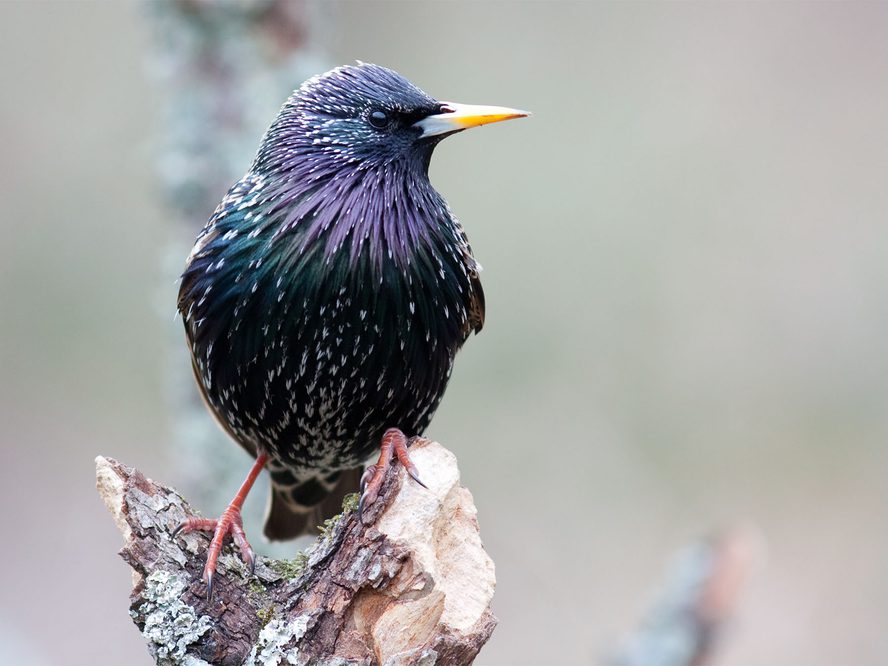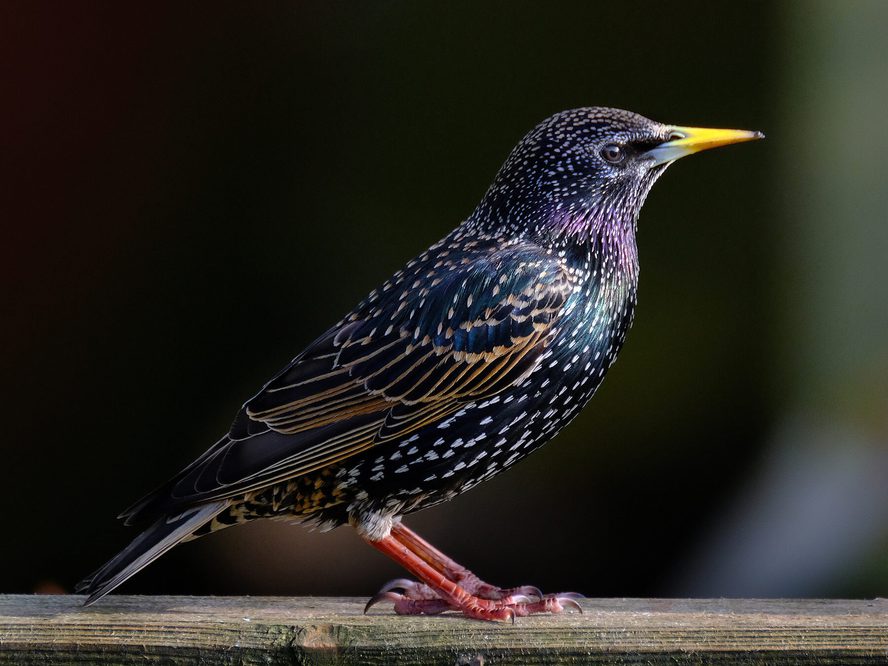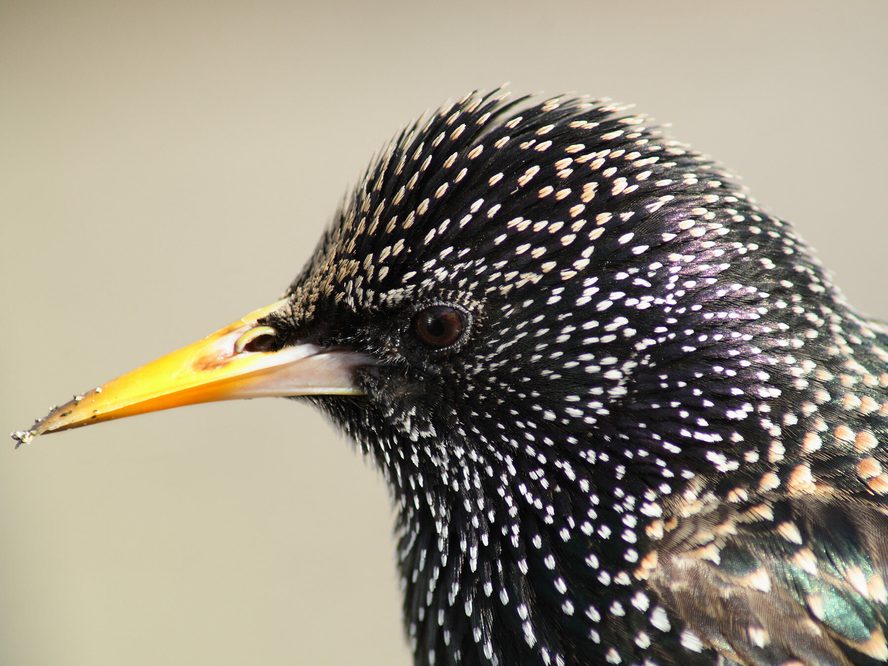Jump to Section
Baby Starlings: All You Need To Know
Last updated: 18 May 2022
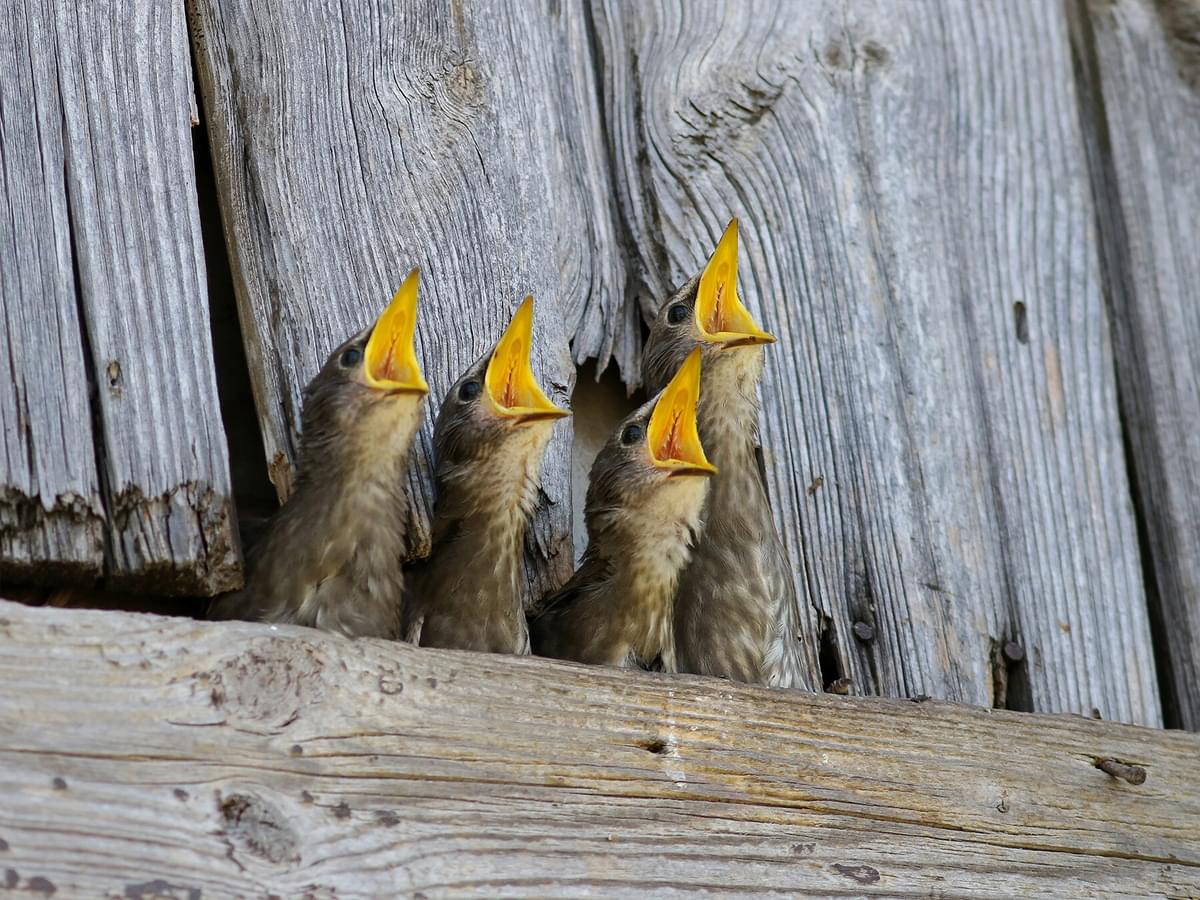
The common or European starling (Sturnus vulgari) is a common and widespread bird found year-round in the UK and many parts of Europe. They were introduced in countries including the United States, Canada, Australia and New Zealand and now have thriving and established populations.
Although they are abundant in most towns, cities and villages in the countryside, little is known what starling babies look like. So we've put together this guide to try and answer the most common questions about young starlings, also including many pictures of starling babies.
What does a baby starling look like?
Newly hatched starlings are pretty much naked and only have a light covering of light grey or white natal down. On the head, the down is usually either brown or greyish. The bill is a vibrant yellow, and the inside of the beak (gape) is bright orange.
Although they hatch pretty much naked, nestling starlings tend to have a more significant amount of natal down when compared to other birds.
Starlings are born altrical, which means they hatch in an underdeveloped state and are essentially helpless and depend on their parents entirely for survival.
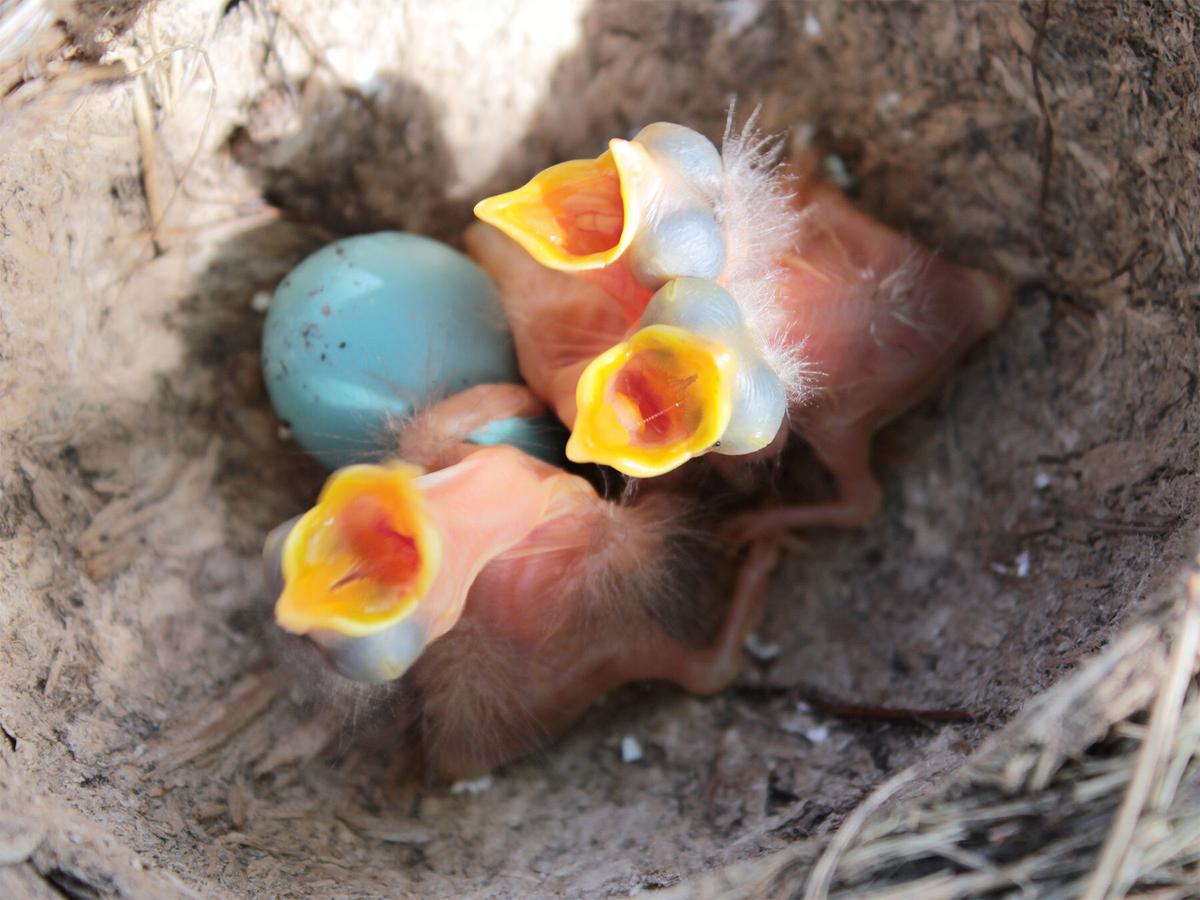
Three newly hatched starling babies (chicks) in nest
Nestlings will start to move when they are two days old and can usually crawl at four days.
The eyes will not usually open until the birds reach an age of between six and seven days old.
The contour feathers are visible under the skin but won't start to erupt until the chick is around a week old. Generally speaking, it takes anywhere from 15 and 21 days for starling babies to become fully feathered.
Nestlings become able to regulate their body temperature when their plumage gets to a certain stage of development. Typically this is when the starling chicks reach around 13 days old.

A starling nestling that has developed feathers
How big is a baby starling?
Starling babies, like most birds, are tiny when they hatch. The upper ridge of the beak (the culmen) is around 8mm, and their legs (tarsus) are just 9mm in length.
How much does a baby starling weigh?
The average weight for a European Starling baby is just 6.4 grams.
Baby starlings increase their mass relatively rapidly during the first eleven to twelve days. Once they reach this age, they usually weigh around 71 grams.
They'll gain around another gram a day for the next week, so at around 18 days, starling chicks weigh about 78 grams. This is generally the heaviest weight the chicks will reach, as at around day 21 or 22, they decline to around 71 grams again.
What does a juvenile starling look like?
Juvenile Starlings are similar in size and shape to adults. They are mainly a light greyish-brown all over, and the chin is lightish, and the breast is buffy white with brown tips. The bill is long and dark. Both the wing and tail feathers have cinnamon colored edges.

Juvenile European Starling
What is a baby starling called?
There are no specific terms for baby starlings, and instead, they are referred to as either a chick, hatchling, nestling or fledgling. The term baby isn't often used by birdwatchers and ornithologists and instead, they will adopt one of the terms mentioned, depending on the stage of the starlings' life.
To find out more about the stages of a baby bird and when these names can be used, click here.
What do baby starlings eat?
Starlings feed their babies with a mixture of small soft-bodied invertebrates, which are brought back to the nest by both the male and female. This varies depending on their habitat but comprises of beetles, caterpillars, millipedes, cranefly larvae, grasshoppers and crickets. These small items are fed to the chicks shortly after hatching, as soon as they are ready to eat. Once the nestlings get a bit older, larger insects and a wider assortment of food will be introduced.
Parents will often bring food items to the nest before the young hatch, building up a small food stock to ensure the nestlings have enough food.
Generally speaking, both the male and female usually will share the feeding duties of the young.
Once young starlings fledge the nest, adults will continue to feed the juveniles for a short while and will start to be introduced to the full, adult starling diet.

Starling fledglings (or juveniles) begging for food
What do starling eggs look like?
Starling eggs are generally a pale blue color, but they may also be white. The average length is 30 x 21mm and has a weight of around 7 grams.
Usually, starlings lay clutches that contain four or five eggs and can have up to 2 clutches per breeding season.

The light blue eggs of a starling in the nest
How long do starling eggs take to hatch?
The eggs of a starling usually take between 12 and 15 days to hatch after they have been laid.
Both the male and female will share incubation of the eggs and often change the duties many times a day. This is because the bouts of incubation can be as low as 10 to 30 minutes before a changeover.
Although both parents will share incubation duties, females tend to be responsible for around 70% of the total incubation and will sit on the eggs throughout the night.
When are starlings born?
In their native range, the breeding season for starlings starts as early as March and goes all the way through to July. In the UK and other northern parts of their range, the breeding season is mainly between April and May and is usually much shorter.
In North America, the breeding season is later and generally between the months of September and December.
How do starlings feed their chicks?
When chicks are young and newly hatched, parents bring back soft-shelled insects and carefully place them in the throats of the begging and hungry chicks.
Feeding their chicks is a pretty intensive process for the parents, with average feeding visits ranging from 100 to 300 times a day. On average, food is brought back to the nest every 14 minutes.
The morning and late afternoons tend to be the busiest times, where starlings can feed their chicks up to 20 times an hour during these parts of the day.

Common Starling feeding chicks
When can baby starlings fly?
Generally speaking, baby starlings are able to fly when they reach about 19 days of age, but this can vary by a day or two depending on the individual. Although they can usually fly quite well at this stage, it doesn't necessarily mean they fledge the nest.
Before they are able to fly, starling nestlings will exercise their wings and legs in the nest to essentially get ready for the outside world.
When do baby starlings leave the nest?
On average, the majority of starling chicks tend to fledge the nest once they get to about three weeks of age (21 days). However, often it may be an additional day or two before they entirely depart the nest.
Once they've fledged, they tend to have most of their feathers and can fly for reasonably long periods, although most of the time, they'll not go travel too far away from the nesting site.
For the first few days after leaving the nest, fledgling starlings are still fed by their parents. They will perch in the trees nearby to where the nest is, waiting to be fed.

A pair of young starlings playing in the sun
Where do starlings nest?
Starlings usually build their nests in holes and cavities, mainly in trees. Houses, buildings, nestboxes and old cavities from Woodpeckers are also frequent places. The main requirement is a hole or cavity.
Once a suitable location has been found, the nest cavity will be filled with a mixture of materials like grass, twigs and pine needles. Other materials like feathers, string, paper, plastics and cloth may also be used too.
The lining of the cup can have a mixture of moss, wool, fine grass, feathers, fine bark and even paper.
Nests can be over 18 metres off the ground in certain circumstances, but the average height off the ground is usually between 3 and 8 metres.

Starlings will often use nest boxes where available
Do starlings reuse nests?
Generally speaking, starlings will not use the same exact nests, but they are known to build on top of old ones, where it is suitable to do so. On average, this is thought to be around a third of females that will return to their previous nesting location and site.
Most starling colonies do tend to return to the same locations for breeding each year, but their fledged young will generally join up and form new colonies in different areas.
How long do starlings stay with their parents?
Once young starlings have left the nest and have reached the fledgling stage, they are usually more than capable of foraging themselves; however, parents will often feed them during the first one or two days after leaving the nest.
In most cases, the fledglings tend to depend on their parents for between ten and twelve days after leaving the nest. The proportion of food provided by the parents slowly declines during this time, with young starlings then having to begin fending for themselves.
Once juvenile starlings become independent of their parents, they will often roost communally with other young starlings and feed in mixed groups containing adults and other juveniles.
Do starlings mate for life?
Starlings tend not to mate for life. They are mainly monogamous, which means they raise a brood with a single partner per breeding season, although this tends to be only for one season or brood even.
Starlings are also known to be polygamous in some cases, meaning that males can have multiple partners during a breeding season and end up producing many broods with different females.
Typically, once starlings have found a mate, males will begin to guard them around four days before egg-laying begins. This guarding consists of closely following the female whilst they are foraging for food and chasing other males away.
This guarding behaviour can end early when the male attempts to attract a second mate at another nest site nearby.

A pair of recently fledged European Starling chicks begging for food
What do you do if you find a baby starling?
The first thing to do when you find a baby starling is to establish whether it is a nestling or fledgling, as this will determine if you need to intervene or not.
If the starling is a fledgling, then it should be ok to be left alone. It's not uncommon for recently fledged birds to spend a day or two on the ground until their flight feathers fully develop. It's best to keep a close eye from afar, as the parents are usually nearby in a tree keeping watch.
The only time to intervene with a fledgling is if there is any nearby threats or danger. Such as if they are near or on the road or pets that could easily get the young starling.
Nestling starlings are easy to identify as they will have fewer feathers or none at all.
If you establish that it is a starling nestling and that it looks healthy, then you're the best bet is to see if you can locate the nest and put it back in there when the parent is not around, with as little disturbance as possible.
It's a common misconception that if you put a baby bird back in the nest, that parents will reject it. Starlings (and all birds) tend to have pretty bad senses of smell and will not reject their chicks if humans have handled them.
If the young starling nestling appears injured or sick, then it's not best to put it back in the nest, as it may have been rejected. In this case, you're best off placing the starling chick inside a cardboard box that has been lined with paper towels, and then contact your local wildlife authority or professional.
Why can't I raise the starling chick myself?
Whilst it may be tempting for you to raise the baby starling on your own, our general recommendation is best left to the experts.
It is a nice gesture to think of raising the young starling chick back to full health and then letting it off into the wild, but they do require special diets and feeding regimes. There are plenty of resources on the internet on raising starling chicks, but as previously mentioned, it's generally best left to the professionals.
On this page
- What does a baby starling look like?
- How big is a baby starling?
- How much does a baby starling weigh?
- What does a juvenile starling look like?
- What is a baby starling called?
- What do baby starlings eat?
- What do starling eggs look like?
- How long do starling eggs take to hatch?
- When are starlings born?
- How do starlings feed their chicks?
- When can baby starlings fly?
- When do baby starlings leave the nest?
- Where do starlings nest?
- Do starlings reuse nests?
- How long do starlings stay with their parents?
- Do starlings mate for life?
- What do you do if you find a baby starling?
- Why can't I raise the starling chick myself?





